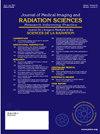Interactive 3D Models and Animations for Cardiac Imaging Education
IF 1.3
Q3 RADIOLOGY, NUCLEAR MEDICINE & MEDICAL IMAGING
Journal of Medical Imaging and Radiation Sciences
Pub Date : 2024-10-01
DOI:10.1016/j.jmir.2024.101547
引用次数: 0
Abstract
Background
Cardiac imaging is a specialized branch of medical imaging that focuses on capturing detailed images of the heart. The coronary angiography procedure is one of the cardiac imaging techniques where radiographers use different angles and projections to get a comprehensive view of the coronary arteries in the heart and assess any potential blockages or abnormalities. Radiography student needs to grasp the theoretical and practical knowledge of these procedures before attending their clinical attachments and working in the field. However, the current teaching relies on static visualization (eg. still illustrations and photographs) which is insufficient to deliver the complex concepts in cardiac imaging. Practical sessions are challenging due to the limited access to the facility and involve ionizing radiation. Integrating 3D models and animations into e-learning for teaching cardiac imaging can significantly enhance the learning experience and provide an immersive and interactive environment.
Methods
3D models and animations were developed using Autodesk Maya software from creating 3D models to animations and rendering of coronary angiography procedures demonstrating different angles and projections.
Results
3D models and animations provide a dynamic visualization of the complex imaging procedure. All animations also provide a short description of each angulation, projection, and image, as well as other important notes related to clinical applications and scenarios. This allows students to learn the real-life scenarios and situations they might encounter in imaging patients in the hospital. This study could be extended for visualization in augmented reality (AR) where students can turn the 3D models around and manipulate the model in their own hands to perform the coronary angiography procedure.
Conclusion
3D models and animations in cardiac imaging education simplify abstract processes and enhance understanding, in line with the needs of the current generation and the fast-paced Industrial Revolution 4.0 (IR 4.0).
用于心脏成像教育的交互式 3D 模型和动画
背景心脏成像是医学影像的一个专业分支,重点是捕捉心脏的详细图像。冠状动脉造影术是心脏成像技术中的一种,放射技师通过不同的角度和投影来全面观察心脏的冠状动脉,并评估任何潜在的阻塞或异常。放射摄影专业的学生在参加临床实习和工作之前,需要掌握这些程序的理论和实践知识。然而,目前的教学依赖于静态视觉(如静态插图和照片),不足以传递心脏成像的复杂概念。由于设施有限,且涉及电离辐射,实践课程具有挑战性。方法使用 Autodesk Maya 软件开发三维模型和动画,从创建三维模型到演示不同角度和投影的冠状动脉造影术的动画和渲染。所有动画还提供了每个角度、投影和图像的简短描述,以及与临床应用和场景相关的其他重要说明。这样,学生们就能学习到在医院为病人成像时可能遇到的真实场景和情况。这项研究可以扩展到增强现实(AR)中的可视化,学生可以将三维模型转过来,用自己的双手操作模型,进行冠状动脉造影术。
本文章由计算机程序翻译,如有差异,请以英文原文为准。
求助全文
约1分钟内获得全文
求助全文
来源期刊

Journal of Medical Imaging and Radiation Sciences
RADIOLOGY, NUCLEAR MEDICINE & MEDICAL IMAGING-
CiteScore
2.30
自引率
11.10%
发文量
231
审稿时长
53 days
期刊介绍:
Journal of Medical Imaging and Radiation Sciences is the official peer-reviewed journal of the Canadian Association of Medical Radiation Technologists. This journal is published four times a year and is circulated to approximately 11,000 medical radiation technologists, libraries and radiology departments throughout Canada, the United States and overseas. The Journal publishes articles on recent research, new technology and techniques, professional practices, technologists viewpoints as well as relevant book reviews.
 求助内容:
求助内容: 应助结果提醒方式:
应助结果提醒方式:


